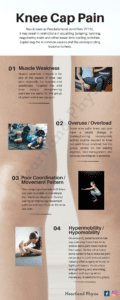What is Knee Cap Pain
It is also known as Patellofemoral Joint Pain (PFPS).
Patella is a small round bone at the front of the knee, located in front of the thigh bone, forming a joint with the latter.
Some people develop pain in this joint, resulting in restrictions in squatting, jumping, running, negotiating stairs and other lower-limb-loading activities.
Differential Diagnoses from Knee Cap Pain
Careful interview on the symptoms and clinical assessments would help differentiate the knee cap pain from other sources of knee pain, including (but not limited to)
- Patellar tendinopathy
- Quadriceps tendinopathy
- Fat pad syndrome
- Tibial apophysitis
- Patellar apophysitis
- Fracture
- Infection
- Nerve irritation
- Tumour
Causes and Treatments of Knee Cap Pain
There is no ‘One-Size-Fits-All’ solution as knee cap pain can arise from different reasons, varying from person to person. Treatments need to be targeting the underlying cause(s) revealed in the interview and clinical assessments. Four major root causes and the corresponding solutions are explained here.
- Muscle Weakness
Muscle weakness is found to be one of the causes of knee cap pain, especially hip muscles and quadriceps. Overseas prospective longitudinal research on military recruits has shown that subjects with poorer quadriceps strength before the training season are more likely to develop knee cap pain after a period of military training. There is also evidence that targeted hip and knee muscle strengthening exercises are better than knee muscle strengthening alone for people with knee cap pain.
- Overuse / Overload
In some of those suffering from knee cap pain, leg muscle weakness was not found in the examination. Instead, a recent change in loading/training intensity/daily activity routine resulted in knee cap joint tissue overload. Overloading could be either a result of an increase in load that ‘surpasses the ability of (the knee cap joint) tissue to recover’ or an insufficient recovery from exercises/training, which lowers the tissue’s capacity to take loading. For this group, advice on the training regimen, load management, and recovery techniques is essential.
- Poor Coordination / Movement Pattern
One subgroup of people with knee cap pain does not have muscle weakness, recent activity level change or insufficient recovery issues. Close observation on movement patterns like walking, running, single-leg squat, etc., however, revealed that these individuals are unable to coordinate their hip/knee alignment (and may involve the back and ankle as well) during these activities. For this group, careful cueing on improving the lower limb kinematics and movement patterns will help improve the knee cap pain.
- Hypermobility / Hypomobility
These are mobility issues at the two ends of the spectrum.
On one end, patients with knee cap pain may have their knee and/or ankle joint more mobile than usual e.g. due to a ligament sprain or general laxity. In these cases, patients’ presentation may appear like a coordination problem, but the root cause is a hypermobile joint. Such joint(s) need to be stabilized actively through exercises or passively through taping or insole (usually for a short term) to correct the lower limb kinematics.
On the other end of the spectrum, some patients lose joint range through joint immobilization (usually after surgery or injury) or tight soft tissues, e.g., tight quadriceps, hamstrings, iliotibial bands, etc. Such hypomobility needs to be addressed through joint mobilization and/or stretching to alleviate the knee cap pain.
Conclusion
Knee cap pain can be addressed through muscle strengthening, proper load management regimen, appropriate recovery techniques after exercises, coordination and movement pattern training, stretching exercises, adjunct with joint mobilization, taping and/or insole for short term as appropriate.
Reference:
- Willy RW, Hoglund LT, Barton CJ, Bolgla LA, Scaglietti DA, Lagerstedt DS, Lynch AD, Snyder-Mackler L, McDonough CM. Patellofemoral Pain: Clinical Practice Guidelines Linked to the International Classification of Functioning, Disability and Health From the Academy of Orthopaedic Physical Therapy of the American Physical Therapy Association. J Orthop Sports Phys Ther 2019;49(9):CPG1-CPG95
- Duvigneaud N, Bernard E, Stevens V, Witvrouw E, Van Tiggelen D. Isokinetic Assessment of Patellofemoral Pain Syndrome: A Prospective Study in Female Recruits. Isokinetics and Exercise Science 2008; Vol 16(4): 213–219
- Van Tiggelen D, Witvrouw E, Coorevits P, Croisier JL, Roget P. Analysis of isokinetic parameters in the development of anterior knee pain syndrome: a prospective study in a military setting. Isokinet Exerc Sci 2004;12:223-228

